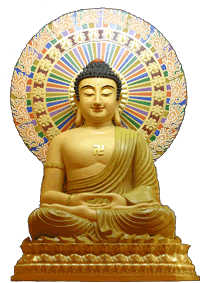
You will sometimes come across the idea of the “32 Marks of the Buddha.” These are mentioned in the Lakkhana Sutta and are very cultural in origin. Gautama, the historical Buddha, liked to give new meaning to teachings that were already around in the Indian tradition, rather than preaching against them. The Lakkhana Sutta is a good example of this. The idea of the marks already existed as the list of the “32 Marks of a Superior Being.” What the Buddha added was the teaching that each of these marks is the result of ethical action in the past. For instance, the wheel-mark on the foot comes from having “lived for the happiness of many, a dispeller of fright and terror, provider of lawful protection and shelter, and supplying all necessities.”
The Marks of a Superior Being are:
- He places his foot evenly on the floor
- The soles of his feet are imprinted with wheels
- He has projecting heels
- He has long fingers and toes
- He has soft and tender hands and feet
- He has webbed hands and feet
- He has arched feet
- He has legs like an antelope
- When he stands upright his hands reach down to his knees
- His male organ is covered with a sheath
- His complexion has a golden sheen
- His skin is so smooth that no dust clings to it
- Each hair on his skin grows from a single pore
- The hair on his skin is blue-black, curly and turns at the end to the right
- His limbs are straight like those of a god
- There are seven convex surfaces on his body – four behind his limbs, two behind his shoulders and one behind his trunk
- His torso is like that of a lion
- The furrow between his shoulders is absent
- His body is perfectly proportioned – the span of his arms is the same as his height
- His neck and shoulders are evenly proportioned
- His taste is exceptionally sensitive
- His jaws are like those of a lion’s
- He has forty teeth
- His teeth are even
- There are no gaps in his teeth
- His teeth are white and shining
- He has a long tongue
- He has a divine voice
- He has deep blue eyes
- He has eyelashes like those of an ox
- He has soft white hair growing between his eyebrows
- His head is shaped like a turban the two, are excellently smooth
The protuberance at the crown of the Buddha called Usnisha, is a symbol of Supreme Enlightenment and wisdom. It is a cranial protrusion, covered with short curls which turn clockwise.This is known to be one of the 32 auspicious physical marks of the Buddha.
An Urna is a concave circular dot- an auspicious mark manifested by a whorl of white hair on the forehead between the eyebrows. It is often found on the 2nd and 3rd Century sculptures of the Buddha and Bodhisattvas. Sometimes it is represented with a jewel.
Urna is the 31st physical characteristic of Buddha. It symbolizes and radiates wisdom.which illuminates the world.
The distended earlobes, symbolic of longevity, which recall the heavy earrings the Buddha wore when he was still a prince.
(Source: FGS Nan Tien temple’s webpage “32 Marks of the Buddha”.)
